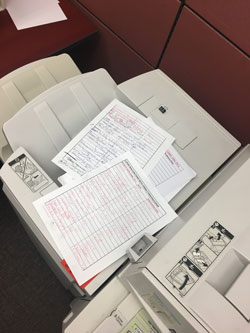The Department of Communication at Monmouth consists of 50 employees, 400 undergrad students and just one copy machine, which has gained a reputation for improperly functioning the past two semesters.
Most departments at Monmouth University depend on their copy machines as a way to pass information on to students for classwork and homework. The malfunction or absence of these machines can cause problems for several classes, and delay the work that needs to be done.
Dr. Marina Vujnovic, associate professor of communication, “I never imagined that something like copier could effect my classes as much as it did. I have to re-think assignments and activities and utilize ecampus more because I can’t make enough copies for handouts. Especially difficult situation is with the midterm. I like to give traditional paper exams. I think they are psychologically less frightening for students but this time around I had to do ecampus exam. This situation has been frustrating for many faculty and quite honestly inexcusable.”
Today a copy machine might seem like more of an outdated piece of technology, being that they were put on the market in 1959, according to Smithsonianmag.com. Almost 60 years later, this technology is still used on a daily basis, especially on college campuses. On Monmouth’s campus, there are about 100 copy machines. These machines are maintained and supervised by Monmouth’s Digital Print Center (DPC).
David Tsang, Manager of the DPC, explained that there is an on-sight tech that’s on campus who can repair copy machines with a temporary fix until parts for a permanent fix are ordered.
Tsang said, “Sometimes there are parts for the machine that are broken that need a replacement part. We don’t have all of these parts on campus, so temporary fixes are made to the machine while parts are ordered.”
The machine is used by several faculty members a day and Tsang explained that sometimes mistakes on the operator’s end could cause problems with the machine.
Dr. Aaron Furgason, Chair of the Department of Communications, said, “I was aware that issues existed with the copier. There were occasional issues during the fall term with the copier. Once the spring term began, those issues multiplied by a ten-fold increase.”
According to Dr. Furgason the Department of Communications is in serious need of a functioning copier. With faculty relying on a faulty machine, it not only frustrates the user, but students who should be receiving work or even tests and projects.
John Morano, professor of journalism, said, “This department consists of some 400 undergraduate students, a graduate program, several dozen faculty and staff and yet has no fully functioning copier. Under the best of conditions, it’s a bit of a feat making everything work smoothly, without a copier, it’s somewhat absurd.”
According to Tsang the copy machine in the department comes with an interesting history. He said, “When the machine was brought to the department the plug required a special outlet that it needed to be plugged into. Instead of replacing the outlet, facilities cut through the wires and replaced the plug.”
Tsang explained how this could have led to the copy machine possibly not receiving enough power, which could explain the recent malfunctions of the machine and its inability to continue working.
Faculty are not the only ones who are impacted by recent influx of copy machine malfunctions. Aditi Vast, a senior communication student, said, “I’ve had classes where we couldn’t receive handouts for homework because there was no way to make copies of the material.”
Faculty have resorted to using other printers in the building when the copy machine is down. There are several printers in The Jules L. Plangere Center, but different student organizations are dependent on these machines and Tsang explained that constant use of any machine will cause it to wear down.
Morano explained, “If the department’s copier is on the fritz (which is the case this semester) the only other practical option is what we’ve done, roll over the copier from WMCX, which is much smaller and not really up to the task.”
Anthony Papetti, a senior communication student and WMCX e-board member, said, “It was very convenient to have a usable printer/copier right where you work. Not having it and knowing it went to staff who already have a great amount of resources is frustrating since we get in trouble whenever we would use their printer to print important material.”
“The Communication Department took the copier right out of my office without any notice. Now there’s a huge gap in my office, I don’t know how I’ll get by, the rest of the semester,” said Ali Nugent, music director at WMCX.
There are several factors that could be leading to the issue of the copier being out of use, but Tsang explained the idea isn’t to find who to blame, but who can fix the problem.
Dr. Furgason said, “The department is scheduled to get a replacement copier in July. Not ideal for the department or students in Communication, but we will have to function as best as we can under the circumstances.”
Tsang’s response to the current copier issue is that the DPC is hopeful on replacing the copier in the department sooner than July. Until there is a permanent fix, Tsang suggests that professors utilize the Digital Print Center as a way to make do with their issues as it is always available for students and faculty to take advantage of.
IMAGE TAKEN by Amanda Drennan



